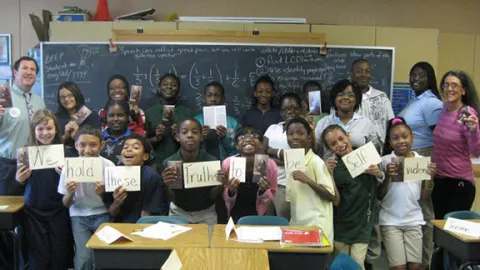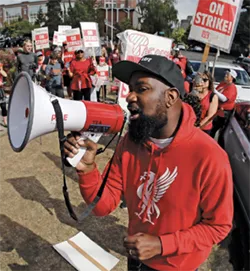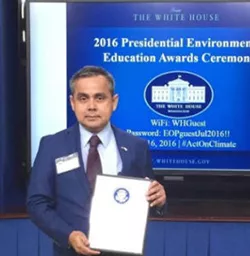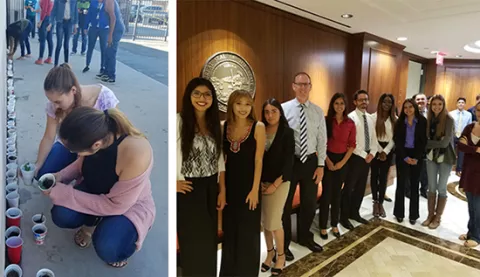Florida teacher Sherri Moss clearly recalls the day she realized her fifth graders had not acquired the fundamentals of civics education.
It was the Friday following the 9/11 attacks—a tough week. That day the students and teachers had gathered to watch part of a ceremony honoring those lost. When the gentleman on the TV began reading the Declaration of Independence, Moss was moved to recite it, word for word, right along with him.

“My students’ jaws dropped and they blurted out, ‘How did you know what he was going to say?!?’ And that’s when I realized they had absolutely no familiarity with our founding documents.”
Civic knowledge has been low for decades among all American students. Only 23 percent of the nation’s eighth graders scored proficient on the civics portion of the 2014 NAEP (National Assessment of Educational Progress) test, which requires a basic understanding of the Constitution and the branches of government.
Equally disconcerting is the persistent gap in scores between white students, 26 percent of whom scored proficient or above in 2014, and those of black and Hispanic students, less than 10 percent of whom scored proficient.
Those results reflect the fact that rigorous civics education—where textbook learning is supplemented with guided debates, government simulations, community problem-solving projects, and field trips to see local and state government in action—is far more commonly found in schools that serve the wealthiest communities, in which black and Hispanic families are underrepresented.
“A lot of research shows that schools that serve youth of color or poor youth provide the least innovative and most ineffective forms of civic education,” says Stephanie Serriere, a professor of social studies education in the Indiana University system.
It’s a loss for students of color who aren’t learning to access the levers of power, but it’s also a loss for their more privileged peers, she explains.
“Youth of color have particular knowledge about the unequal implementation of democracy that white youth may not have or recognize,” says Serriere. “But our classrooms can be places where our students have opportunities to notice inequities and take action on them.”
Students like those Sherri Moss teaches, students of color who are economically disadvantaged, are less likely to ever have opportunities to engage deeply in civic learning.
Moss set out to change that, at least in her classroom, though some of her colleagues were skeptical.
The student body at Bethune Elementary School of the Arts in Hollywood, Fla., included more low-income and non-English speaking students every year, and their school kept a laser-focus on standardized test prep. How would she fit in civics content?And even if she could, how would she get students interested?
Moss was undeterred. She encouraged the lively debates that arose as students learned more about our system of government. She soon had students creating their own slideshows about the Bill of Rights. She helped them look up the meanings of 18th-century words and figure out unfamiliar phrases.
“How is that not working on important reading skills?” Moss asks enthusiastically. “Pretty soon they were working on memorizing it, too. A lot of people didn’t think my kids could do it, but I knew they have a deep desire to talk about the principles of fairness and justice.”
In 2005, her then-principal asked Moss to participate in Justice Teaching, a program of the Florida Bar that pairs a lawyer-volunteer with a class in a low-income school. She jumped at it. For nearly 15 years, Moss and her volunteer, Bruce Blitman, partnered in teaching aspects of law and government through games and projects, and inviting guest speakers who “really connected with the kids,” says Moss.
R. Fred Lewis, the former Florida Supreme Court chief justice who founded the Justice Teaching program, drove seven hours to meet Moss’ students in person. “I wore a dress that day,” Moss recalls. “The kids were freaking out.”
In one Justice Teaching lesson, the children start playing a game, and then the rules change on them halfway through. It drives home why it is so important that our laws apply to everyone.
Another lesson asks the children to choose five rights from the Bill of Rights that they would want to keep if they were forced to sacrifice the others.
“Speech, religion, and the right to bear arms are usually in the top five,” says Moss. “But then we discuss what happens if you have freedom of religion without the freedom of assembly. Can you go to church?”
The activity shows students how our fundamental rights are inextricably linked, and how our democracy would collapse without all of them.
Beyond these specific lessons, Moss and her students discuss how important it is to make good choices, treat everyone with respect even when we disagree, and why the rules apply to everyone—including law enforcement.
“These kids are dealing with a level of violence in their communities, and some of their family members have had negative interactions with police officers,” says Moss. “I want them to know their rights. I want them to know the police can’t just barge into their homes without a warrant.”
“I want them to know that they have good reason to expect fair treatment.”
Keeping It Real
The need for real-life relevance doesn’t wane as students get older according to Nathan Bowling, who has taught civics, government, and geography in Tacoma, Wash., for 13 years.
“What I know about civics instruction is that relevance drives engagement, so when my teaching is most relevant, my students are most engaged,” says Bowling, who was named Washington’s Teacher of the Year in 2016.

Ten years ago, he left his position at one of the district’s wealthiest middle schools to teach at Lincoln High School, a highly diverse, low-income school across town. Conversations about law enforcement and immigration are particularly relevant to his students.
“When we study civil liberties, I don’t avoid talking about search and seizure. I do a really deep dive on how to handle police encounters, because we have situations where officers interact with our students,” Bowling says.
About the only thing that truly surprises them is the potential for corruption in our political system.
“When I explain how campaign finance works, with independent expenditures and contribution bundling, students are shocked,” he says.
A South American exchange student in his class two years ago was aghast, saying, “Brazil has a reputation for corruption, but we would never allow this! It’s buying politicians!”
Bowling is cautious though—he wants his students to be skeptical of power structures without becoming cynical. He’s found that lessons on local government are an effective antidote to cynicism, because students can see more clearly how much their participation matters.
“It’s easy to feel outrage about things going on in Washington, D.C., but folks on Capitol Hill aren’t the ones deciding which potholes get filled and why your train stops running at 10 p.m.,” Bowling says. “Those are all local decisions.”
Bowling requires his AP government students to engage in local politics and attend local school board and community meetings.
And anyone who says individual votes don’t really count, in reference to the shortcomings of the electoral college, will be stopped in their tracks if Bowling is within earshot. “I tell them that every election we vote for local officials and legislators who determine a lot of the real outcomes of our lives.”
He asks students to examine how their home state came to have the highest minimum wage in the nation, and how same-sex marriage and marijuana were legalized—all via grassroots-driven ballot initiatives.
Bowling is moving overseas for at least a few years, but he hopes his students will remember one of the sayings from his class: “Democracy is a lifestyle.”
In other words, Bowling explains, voting once or twice a year is not going to be enough to protect our democracy.
Time to Act
Former civics teacher Jose Flores didn’t let his students’ disadvantages prevent them from learning how to advocate for positive change in their rural agricultural community in Imperial County, the poorest county in California.
Brawley Union High School, just 20 minutes from the border with Mexico, is home to many low-income students. Some are the children of migrant workers; some work in the fields themselves, as Flores did in his youth.

“Some of my students struggle to learn English, and some are illiterate in Spanish as well,” says Flores. “It would be a terrible disservice to hand them a textbook and test them on vocabulary and call that their education.”
Instead, Flores set out to show them that what he had to teach is critical to their daily lives. He would teach them to integrate critical thinking with advocacy—but the students would decide what issues they would take on.
If he could help his students understand the levers of power, they would be comfortable enough to speak out before an audience that could actually change things. They didn’t just read about American government; his students went to city council and school board meetings, contacted state assembly members, and ran information campaigns in their neighborhoods.
Students weren’t just passive observers to the political process. Flores showed them how to obtain the city council’s proposed budget document, for example, and analyze revenues and expenditures to figure out where resources were going. Then, when they attended council meetings, they could question why there was so much investment in some areas when they were told there wasn’t enough money to add police officers in their neighborhoods.
“After taking my class, my students knew everyone in their city government, and those individuals knew my students, too,” Flores says.
Adjoining rooms had to be opened at school board meetings to make room for 100 students from Brawley.
But the most urgent work his students became engaged in was exploring the environmental conditions in their own hometown.

For 20 years, the county has diverted water from the Salton Sea to big cities like Los Angeles. Meanwhile, pesticides and industrial wastewater have poisoned the New River, which flows right through Brawley. As water evaporates, sand covered in toxic chemicals blows in the air.
“We have terrible air and water quality here, and the highest asthma rate in the state,” says Flores.
His students have taken soil and water samples, held press conferences where they discussed their own health issues and those of family members, and conducted letter writing campaigns to state and federal officials.
So far, the 300,000 residents of Imperial County have been outvoted by Los Angeles and San Diego, and no action has been taken to improve the environmental conditions.
But another important lesson Flores hoped to impart was that “if your side or your candidate loses, you can’t give up. You have to keep pushing for positive change.”
After 25 years in the classroom and numerous honors for his work in civics education and environmental literacy, Flores had to stop teaching in 2018. His own health problems, likely connected to the pesticides he has been exposed to his entire life, are getting worse, and his ailing mother needs more help.
But Flores has continued to push for change in how schools understand and implement civics. He served on a state commission on environmental literacy, and is now working with the state university teacher prep program to show how cross-curricular lessons are essential for preparing students to tackle the climate crisis.
Why can’t a language arts teacher also encourage letter writing campaigns? Why shouldn’t a civics teacher encourage students to use data and figure out ratios and percentages to bolster their advocacy?
“We have to stop thinking in silos,” says Flores. “No teacher has to be the expert on everything, we just have to work together and bring in experts who want to help.”
When the journalism program at San Francisco State University offered to do workshops for his students, Flores followed up by making them honorary press passes and asking them to become reporters at school board and city council meetings.
It’s just another skill set that his students can use to fight for their futures.
Students of color whose families are not wealthy are the students who most need educators willing to take risks and teach outside of textbooks, says Flores.
“If we’re doing our job well, we’re helping our students to find a voice and use it.”
For more information, including lesson plans, go to nea.org/civicseducation
